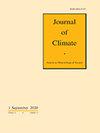Two perspectives on amplified warming over tropical land examined in CMIP6 models
IF 4
2区 地球科学
Q1 METEOROLOGY & ATMOSPHERIC SCIENCES
引用次数: 0
Abstract
Abstract Climate change projections show amplified warming associated with dry conditions over tropical land. We compare two perspectives explaining this amplified warming: one based on tropical atmospheric dynamics, and the other focusing on soil moisture and surface fluxes. We first compare the full spatiotemporal distribution of changes in key variables in the two perspectives under a quadrupling of CO2 using daily output from the CMIP6 simulations. Both perspectives center around the partitioning of the total energy/energy flux into the temperature and humidity components. We examine the contribution of this temperature/humidity partitioning in the base climate and its change under warming to rising temperatures by deriving a diagnostic linearized perturbation model that relates the magnitude of warming to (1) changes in the total energy/energy flux, (2) the base-climate temperature/humidity partitioning, and (3) changes in the partitioning under warming. We show that the spatiotemporal structure of warming in CMIP6 models is well predicted by the inverse of the base-climate partition factor, which we term the base-climate sensitivity: conditions that are drier in the base climate have a higher base-climate sensitivity and experience more warming. On top of this relationship, changes in the partition factor under intermediate (between wet and dry) surface conditions further enhance or dampen the warming. We discuss the mechanistic link between the two perspectives by illustrating the strong relationships between lower tropospheric temperature lapse rates, a key variable for the atmospheric perspective, and surfaces fluxes, a key component of the land surface perspective.在 CMIP6 模型中研究热带陆地变暖扩大的两个视角
摘要 气候变化预测显示,热带陆地的变暖与干燥条件有关。我们比较了两种解释这种变暖扩大的观点:一种基于热带大气动力学,另一种侧重于土壤湿度和地表通量。我们首先利用 CMIP6 模拟的每日输出结果,比较了在二氧化碳增加四倍的情况下,两种观点中关键变量变化的全部时空分布。这两个视角的核心都是将总能量/能量通量划分为温度和湿度两个部分。我们通过推导一个诊断性线性化扰动模型,将气候变暖的程度与(1)总能量/能量通量的变化、(2)基础气候的温度/湿度分区以及(3)气候变暖下的分区变化联系起来,来研究基础气候中的温度/湿度分区及其在气候变暖下的变化对气温上升的贡献。我们的研究表明,CMIP6 模型中气候变暖的时空结构可以很好地通过基础气候分区因子的倒数(我们称之为基础气候敏感性)来预测:基础气候更干燥的条件具有更高的基础气候敏感性,并经历更多的气候变暖。在这种关系的基础上,中间(介于潮湿和干燥之间)地表条件下的分区因子的变化会进一步增强或抑制气候变暖。我们通过说明对流层低层温度失效率(大气视角的关键变量)与地表通量(陆地表面视角的关键组成部分)之间的密切关系,讨论了这两个视角之间的机理联系。
本文章由计算机程序翻译,如有差异,请以英文原文为准。
求助全文
约1分钟内获得全文
求助全文
来源期刊

Journal of Climate
地学-气象与大气科学
CiteScore
9.30
自引率
14.30%
发文量
490
审稿时长
7.5 months
期刊介绍:
The Journal of Climate (JCLI) (ISSN: 0894-8755; eISSN: 1520-0442) publishes research that advances basic understanding of the dynamics and physics of the climate system on large spatial scales, including variability of the atmosphere, oceans, land surface, and cryosphere; past, present, and projected future changes in the climate system; and climate simulation and prediction.
 求助内容:
求助内容: 应助结果提醒方式:
应助结果提醒方式:


